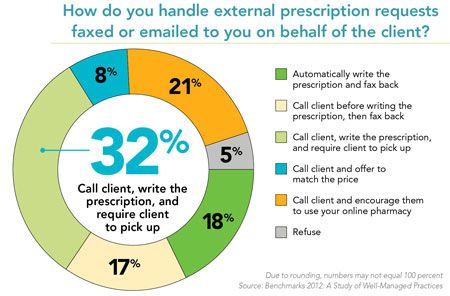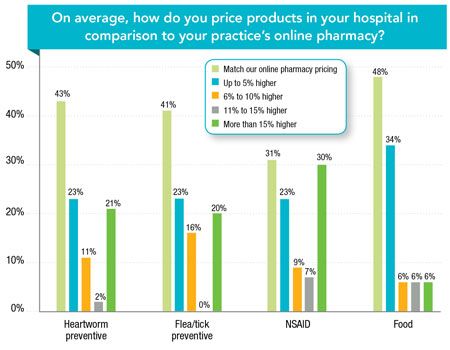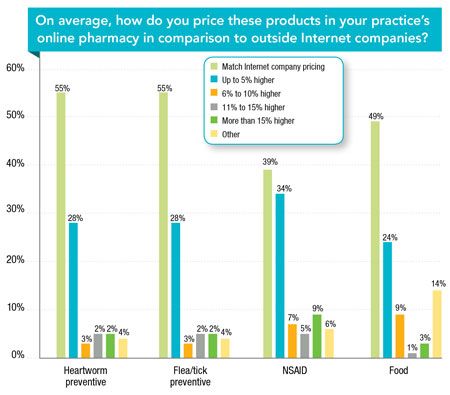Homeward bound
What's more convenient than a visit to the veterinary practice? When the veterinarian offers an online pharmacy to deliver drugs right to clients' doorstep. Here's why you should be that doctor.
Next >
In 2005, 12 percent of participants in Benchmarks: A Study of Well-Managed Practices by Wutchiett Tumblin and Associates and Veterinary Economics reported a 6 percent to 10 percent decline in the volume of medication dispensed because clients were using Internet pharmacies. In 2011, that number had more than doubled, with 32 percent of practices reporting a similar decline.
For many practices, this loss of pharmacy revenue poses a serious threat, not only from the pharmacy standpoint, but also from losses in service revenue. Studies show that product purchases, particularly heartworm, flea, and tick products, help drive client visits to the veterinarian. In 2011, Elanco surveyed 1,600 dog owners and found that owners who purchased flea and tick medication through their veterinarian visited the practice more often than owners who purchased from warehouse retailers or Internet pharmacies not associated with a veterinary practice.
That Elanco study also found that four out of five dog owners purchase their flea medication from just one place. Unfortunately, only 36 percent bought flea medication exclusively from their veterinary clinic, which can lead to declines in visits and gaps in the medical care pets receive.
So with more and more players entering the veterinary pharmaceutical sales market every day, what steps can you take to protect your practice? I propose it’s time to offer your clients an online pharmacy option through your practice.
‘It ensures the medication is safe and reliable’
More than half of practices surveyed in Benchmarks 2012 have an online pharmacy, but with a mere 5 percent of pharmacy revenue generated through those online stores, is it worth the effort? And does a practice’s online pharmacy further erode in-house pharmacy sales?
Well, we know that consumers shop online (probably you too). We like the convenience of shopping when it suits us—even if it’s 3 a.m. So it’s important to have an online option for your practice rather than give up clients who’ll go elsewhere to get their “fix” of online convenience. An Internet pharmacy doesn’t replace your in-house pharmacy; it’s just an adjunct to it.

Start with products that are readily available from other sources. Consider some of the heartworm, flea, and tick products, medications for chronic conditions, and diets. Then strategically add medications you may not use very frequently but want to have available for patients when needed.
Dr. Phillip Lanzi, owner of College Road Animal Hospital and Carolina Beach Animal Hospital in Wilmington, N.C., says his online pharmacy lets him keep his inventory small and still give clients options.
“We have a few clients who prefer a heartworm medication we don’t stock in-house, but they can buy it through our online pharmacy,” Dr. Lanzi says. “It allows us to ensure the medication is from reputable channels, is direct from the manufacturer, and is safe and reliable.”
‘Free prescriptions’
When it comes to protecting your pharmacy, education is key. Be sure clients understand the value of buying from your practice, even if they spend a few extra dollars. When clients buy from you, they support local business. Independently owned businesses help create a vibrant community and personality that’s different from any other place. Local businesses increase local employment and relationships, and lower transportation and environmental costs. Plus, more money stays in the community, which is a win-win all the way around.
Many consumers believe everything is less expensive in big-box stores and online stores, but that isn’t always true. Big-box retailers often use medications as loss leaders to attract consumers, who pick up additional items while they’re wandering through the store or waiting for the pharmacist to fill the prescription. Those impulse purchases boost the store’s bottom line and represent incremental income that might not have happened had the consumer not come in for the medication.

One veterinarian shared an experience related to these “free prescriptions” offered by several human pharmacies in his area. He had prescribed two medications for one of his patients. One of the medications was indeed free at the nonveterinary pharmacy, so the client asked for a prescription to fill both medications there. The second medication, however, ended up costing about $80 more than what the veterinarian would have charged for both prescriptions together. Lesson learned: You and your clients need to be smart about prices, as big-box stores don’t always cost less.
Veterinarians are also privy to drug promotions and discounts that they pass on to pet owners, making it more economical to buy directly from you. But clients don’t realize this unless you point it out regularly and do the math for them. Consider creating a cost-comparison handout to educate clients about the similarities in your pricing to other online pharmacies or big-box retailers. In many cases, your pricing will even beat the competition.
A consumer’s perception is his or her reality. Do everything you can to ensure that your clients’ perception of your pharmacy matches the reality. See the charts on page 16 and below for more on pricing.
Dr. Bob Beede, co-owner of Intermountain Pet Hospital in Meridian, ID, worked with his pharmaceutical representative to arrange complimentary doses of heartworm medication for his clients when they purchase from his practice.
“We give the free doses to clients if they purchase from our in-house pharmacy or online store during their appointment,” Dr. Beede says. “They only get the free dose if they order during their visit. This accomplishes two things: It keeps them out of the big-box stores and other online pharmacies, and ensures compliance with the pet’s healthcare plan.”
Say it ain’t so!
Perhaps the most interesting numbers in the Elanco study were the differences between what veterinarians and clients perceive to be happening during visits. Roughly 70 percent of veterinarians surveyed said their front staff frequently or always asks clients if they need a refill on their flea and tick products. Yet only 35 percent of dog owners said this was the case. About 65 percent of veterinarians said their veterinary technicians frequently or always educate clients about the importance of flea and tick products. Only 10 percent of the dog owners said this was the case. This disparity represents a significant opportunity to enhance communication, reduce the gap, further bond clients to your practice, and protect your pharmacy revenue.

Done right, incorporating a home delivery pharmacy into your overall strategy can not only enhance your pharmaceutical sales, it can also be an important value-added service for your clients. And, most importantly, it keeps your patients’ healthcare in the hands of the expert—you, the veterinarian. It’s a win-win for your patients, clients, and your practice.
Denise Tumblin, CPA, is president and owner of the veterinary practice consulting firm Wutchiett Tumblin and Associates in Columbus, Ohio. Christina Materni is a financial analyst at the firm.